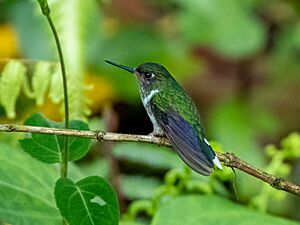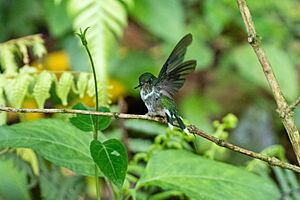Ecuadorian piedtail facts for kids
Quick facts for kids Ecuadorian piedtail |
|
|---|---|
 |
|
| Conservation status | |
| Scientific classification | |
| Genus: |
Phlogophilus
|
| Species: |
hemileucurus
|
 |
|
The Ecuadorian piedtail is a tiny, colorful hummingbird. Its scientific name is Phlogophilus hemileucurus. You can find this special bird in the countries of Colombia, Ecuador, and Peru. It's known for its unique tail feathers.
Contents
What is the Ecuadorian Piedtail?
Scientists group living things into categories. This is called taxonomy. The Ecuadorian piedtail belongs to the hummingbird family. It is in the same group, or genus, as the Peruvian piedtail. This means they are close relatives. The Ecuadorian piedtail is also "monotypic." This means it is the only species in its group that doesn't have different subspecies.
What Does it Look Like?
The Ecuadorian piedtail is a small bird. It is about 7 to 8 centimeters (3 inches) long. It weighs about 2 to 4 grams. That's less than a penny! Both male and female birds look the same.
They have a short, straight, black beak. The base of their beak is yellowish. Their head is greenish-brown. The rest of their upper body is bright grass green. They also have a white spot right behind each eye.
Their throat and chest are white with green spots. A white band separates these areas. Their belly is whitish. The two feathers closest to the middle of their tail are blue-green. The other tail feathers are blue. They have white bases and wide white tips. Young birds look like adults. But their head and neck feathers have soft, buff-colored edges.
Where Does it Live?
The Ecuadorian piedtail lives in the eastern foothills of the Andes mountains. You can find it in parts of Colombia, Ecuador, and northeastern Peru.
It prefers to live at the edges of old, natural forests. It also lives in newer forests that have grown back. These birds live at elevations between 500 and 1,200 meters (about 1,600 to 3,900 feet) above sea level.
How Does it Behave?
Movement
The Ecuadorian piedtail usually stays in one area. However, scientists think it might move up and down mountains. This could happen depending on the season or food availability.
Feeding
This hummingbird usually looks for food about 2 to 4 meters (6 to 13 feet) off the ground. It likes to perch on branches. From there, it sips nectar from flowers. It also picks tiny insects off leaves.
Breeding
The Ecuadorian piedtail's breeding season is from December to April. They build a cup-shaped nest. It is made from thin roots and fern leaves. The nest is usually placed 2 to 3 meters (6 to 10 feet) above the ground. They often build it in vines or under thick plants. A female usually lays two eggs.
Vocalization
The song of the Ecuadorian piedtail is special. It's a series of three high-pitched, buzzing notes. These are followed by several twittering notes. It sounds like "tzeeeee...tzeee.tzew..tititititi" and is repeated often.
Its calls include a descending series of three or four high-pitched "see" notes. It also makes a repeated "tsik" note. Sometimes, it makes high-pitched twittering sounds too.
What is its Conservation Status?
The IUCN assesses the Ecuadorian piedtail. They list it as "least concern." This means it is not currently in danger of extinction.
However, its habitat is facing challenges. Areas where it lives are being changed. This is due to farming and cattle grazing. Other activities like logging and mining also affect its home.



